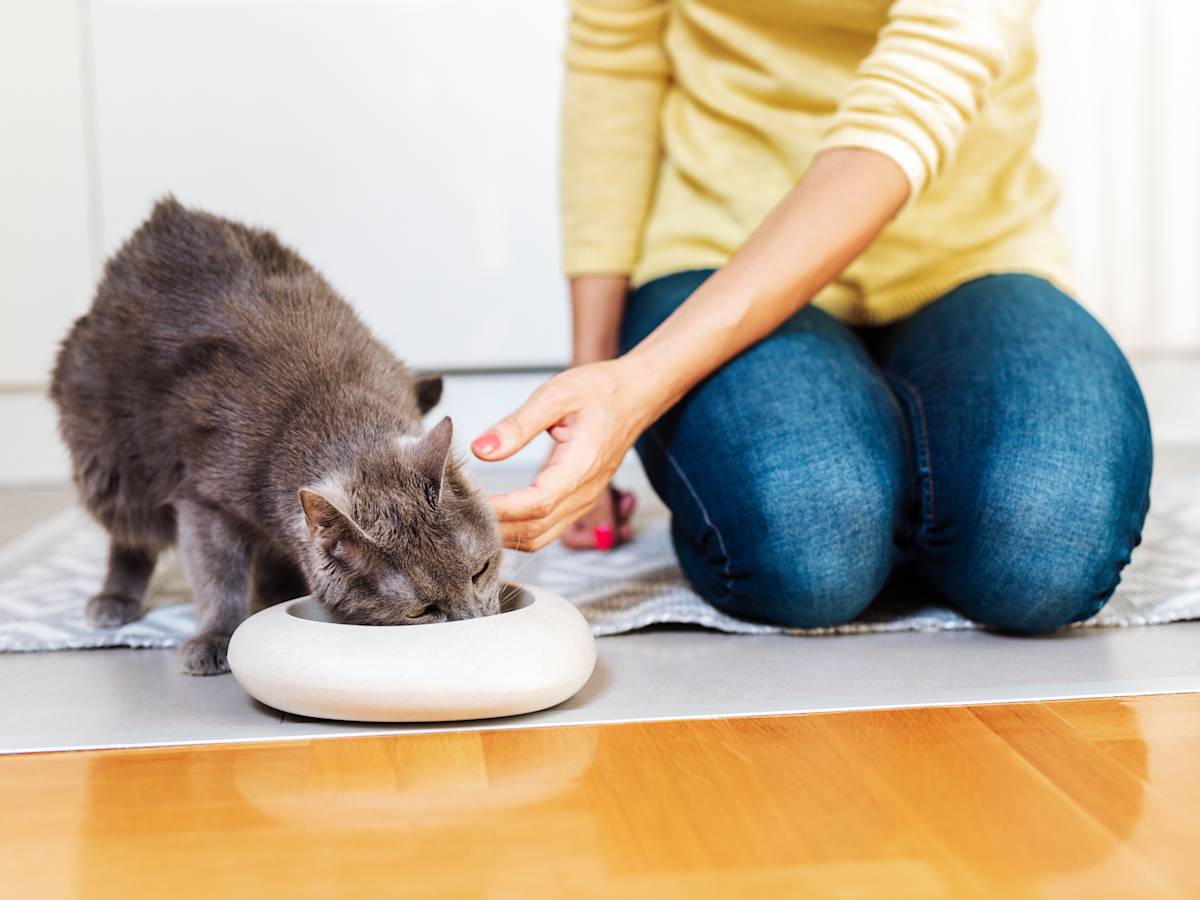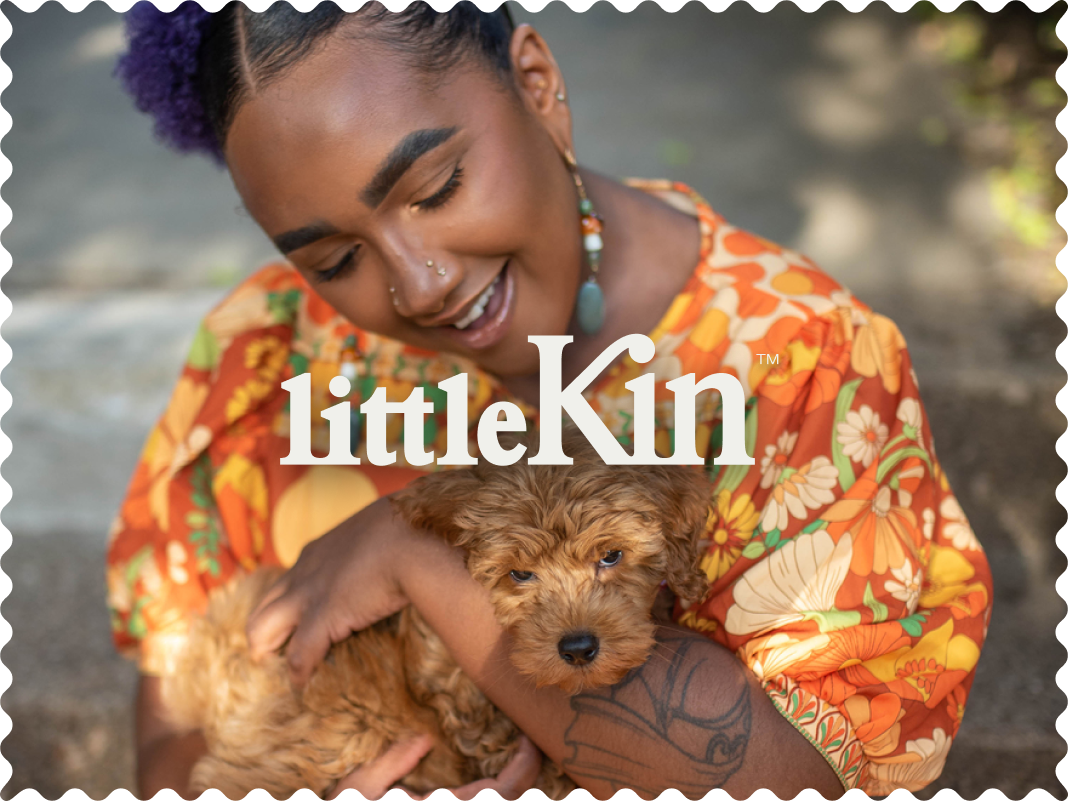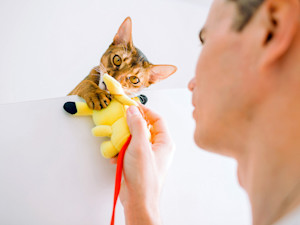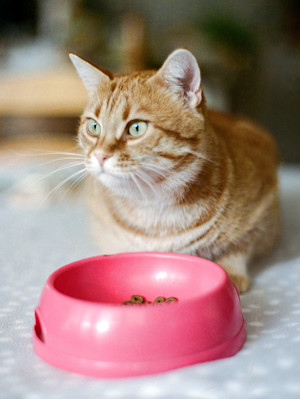Affection Eating: the Viral Cat Feeding Trend That Could Be a Cry For Help
Dining side-by-side with your cat is cute but could it point to anxiety?

Share Article
If you have a cat, you’ll already know they’re full of quirks, especially regarding food. Serve dinner in the wrong spot, a few minutes late or in a bowl that’s seen better days, and you’ll quickly find yourself getting the cold shoulder. And honestly, who could blame them? Mealtime is serious business.
While we might be familiar with the classic cat oddities (overeating, refusing to eat or proudly dropping a dead bird as an appetiser), one lesser-known habit might surprise you. Affection eating is when cats prefer to eat with their humans close by, and sometimes won’t eat at all unless you’re sitting right there with them.
It’s even turned into a TikTok trend, with devoted cat parents plating up their own meals and sitting beside their feline friends like it’s a tiny dinner party for two. Cute? Absolutely. But this behaviour isn’t quite as harmless as it seems and in some cases, it could point to stress, anxiety or an over-dependence that’s worth keeping an eye on.
What is affection eating?
An affection eater is a cat that prefers or requires human interaction to feel comfortable eating. They may eat more when their human is around or might not eat at all if they aren’t. Some cats simply want their human nearby during mealtime, while others enjoy more active engagement such as being petted, hearing the rattle of their kibble bowl, or even being spoon-fed.
It’s not fully understood why some cats become affection eaters, but it’s important to rule out any physical concerns first. If your cat suddenly becomes reluctant to eat or changes their eating habits, always consult a vet first to rule out illness or pain.
If your cat gets the all-clear from the vet, consider their emotional well-being. We’ve gathered some tips from cat behaviourist Katherine Brownopens in new tab, but since every cat is different, it’s always worth speaking to a professional for advice tailored to your feline friend.
Reasons why your cat might engage in affection eating
Anxiety or stress
“The most common reason for affection eating is stress and/or anxiety,” says Katherine. “Your cat might be using their eating behaviour to connect with you or seek reassurance.
“If there has been a sudden change in your cat’s environment such as moving house or a new arrival (pet or baby) in the home, this can cause a lot of stress for your cat, and affection eating could be their way of expressing their feelings.”
Early life experiences
“It’s more common in cats who were hand-raised, bottle-fed, weaned early or removed from their mum early,” says Katherine. “This is because they have developed strong bonds with humans from a very early age and feel more dependent on them for comfort – especially at mealtimes. They’re also more likely to develop an insecure attachment style.”
Learned behaviour
“Cats are excellent at picking up patterns and using them to their advantage,” explains Katherine. “If your cat once hesitated to eat and you responded by cuddling them, rattling the kibble bowl or even feeding them by hand, they may have learned to expect that interaction each time.”
What begins as a one-off reassurance can quickly become a new normal. If the behaviour is reinforced consistently, your cat may come to rely on your presence as part of the mealtime routine.
Signs your cat is an affection eater
So how do you know if your cat is just a bit clingy or an affection eater? Here are some telltale signs Katherine suggests you watch out for:
Your cat only eats when you’re nearby.
They stop eating when you leave the room and/or follow you out.
Your cat has become unusually fussy with food.
They actively seek interaction at mealtimes – petting, spoon-feeding or vocal interaction
How to support an affection eater
Whether your cat struggles with affection eating or not, it’s always a good idea to ensure they feel secure, confident and not overly reliant on your presence to meet basic needs.
Katherine shares some simple ways to help:
Reduce stress around mealtime: keep feeding times calm and consistent. Avoid loud noises, other pets interfering or sudden changes.
Create safe, cosy spots: place their food bowl in a quiet, ideally raised, location where they feel safe and can see what’s going on in the rest of the home.
Make meals part of a wider bond: engage with your cat throughout the day, not just at feeding time. This helps reduce emotional dependency on that interaction.
When can affection eating cause problems?
Occasional affection eating isn’t usually a cause for concern especially if you’ve recently moved house or your cat is adjusting to a change in environment. In these cases, it may simply be a temporary coping mechanism. However, if your cat consistently refuses to eat without you present, shows signs of distress when left alone, or begins to lose weight and eat significantly less, it could point to a deeper issue and should be looked at by a professional.
“Left unaddressed, affection eating can become part of an ongoing cycle of anxiety and may reinforce unhealthy emotional dependencies,” says Katherine. “It’s important to monitor the behaviour and take note if it becomes more frequent or intense over time.”
How to help your cat change affection eating behaviour
If you’d like to gently encourage more confident solo eating, Katherine suggests the following tips:
Experiment with bowl placement: most cats don’t like busy or noisy areas, but placing the bowl near a space where they can observe you (such as the kitchen or hallway) might help. An easily accessible raised position is ideal as most cats feel safer eating in a secure position.
Try different types of bowls: raised bowls can help nervous cats feel more in control of their surroundings, while shallow ones prevent whisker fatigue. Opt for ceramic or glass over plastic or metal, as plastic holds bacteria and some cats don’t like the reflective surface of metal bowls.
Be nearby but not involved: sit near your cat while doing something else (reading, scrolling), so they get used to your presence without expecting loads of interaction.
Keep everything clean: throw away uneaten food promptly and wash bowls thoroughly – cats can be surprisingly picky about freshness (we agree with them on this).
Enrich the rest of their day: a well-stimulated catopens in new tab is a more content and confident cat. Play regularly, offer toys, climbing trees, scratching posts and create cosy hideaways.
Stick to a routine: predictability builds confidence and helps cats feel safe. Keep feeding times consistent and avoid switching foods too often.
When to consult a vet
If your cat:
Suddenly changes their eating habits.
Stops eating altogether when left alone.
Shows signs of anxiety, lethargy or weight loss.
…it’s a good idea to check in with your vet. They can help rule out underlying health issues and, if needed, refer you to a qualified cat behaviourist.
Affection eating can seem cute, and in small doses, it’s often nothing to worry about. But it’s worth paying attention to the emotional and physical reasons behind it. After all, a confident cat is a happy cat, and supporting them to feel secure at mealtimes is one of the best ways to strengthen your bond.

Nuala McHugh
Nuala is a writeropens in new tab with a background in PR. She has worked with brands including Jollyes, Universal Studios, and Amazon. Based in Northern Ireland, she is now doing what she loves most: writing with her clingy cockapoo Bobby by her side.
Related articles
![cat playing with pikachu toy]()
Happy Cat, Happy Life: 5 Enrichment Tips to Keep Your Kitty Content
What is enrichment and why is it so important to keep your kitty happy?
![a picture of a ginger cat sitting in front of a pink plastic bowl with biscuits in]()
‘Whisker Fatigue’ Could Be The Reason Your Cat Isn’t Eating
It’s not just another way for your cat to exhibit diva-esque tendencies
![orange cat looking out window]()
Is Your Cat’s Separation Anxiety Ruining Their Life and Yours?
Why your cat freaks out when you’re away (and how to help)



